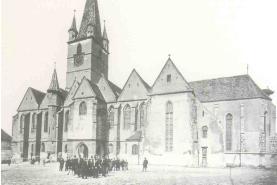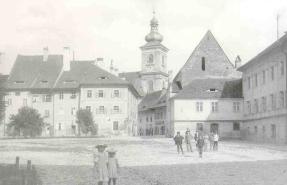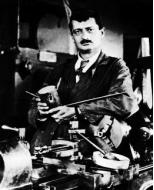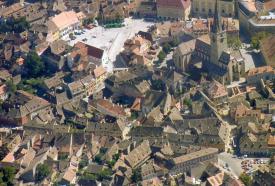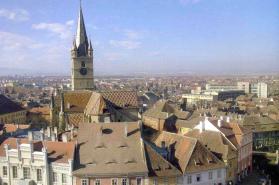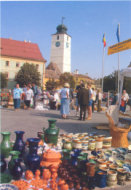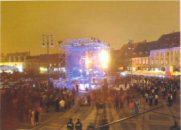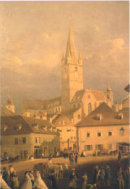| |
In 2007 Sibiu
is the European Capital of Culture together with Luxembourg
Dear Sir/Madam,
This page has been made for you in the name of the
good spirits of this town, in the name of the geniuses
who have bestowed their talent upon this town for
eight centuries. But the town has also been subjected
to hardships, which have molded its appearance, as
you can see it nowadays in its every corner while
taking a walk.
Of course, you are not here to find the routine from
home, but to enrich your mind with living memories
- all these value much more than bought souvenirs
- and Sibiu (Hermannstadt), with its 800 years of
history, will give you the opportunity to take back
home many beautiful memories.
So, the Small Circle or "Circulus parvus" (today's
Small Square) and some of the surrounding streets
must have been there since 1100, because starting
with 1224 Sibiu was the capital of Southern Transylvania,
having its own mint. Nearby is the Great Circle or
"Circulus maior" (today's Large Square), first known
as the grain market, dating as far back as 1400.
|
From the chronicles, we find out that,
after having been invaded by the Tartars, Sibiu (Hermannstadt)
was reinforced with surrounding defence constructions,
which protected the town from the Turks' attacks starting
with 1432, thus making Pope Eugene IV describe it
as "the stronghold defending the whole Christian world."
A lot may be said about the town's guilds (19 in number
in 1376 and 34 in 1724), about the Evangelical Church,
the Town's Gates, the Council Tower, the Brukenthal
Palace and the museum bearing its name, which dates
as far back as 1817 (built 2 years before the Louvre),
Thalia Hall, rebuilt following successive fire outbreaks,
the Old Town Hall and the History Museum, the Natural
Sciences Museum, the original "ASTRA" National Museum
Complex, consisting of a Traditional Folk Civilization
Museum and "Emil Sigerius" Transylvanian Saxon Ethnography
Museum, the Orthodox Cathedral, the Shelter Church,
the Ursulines' Church, the Franciscan Church, the
Church amid Fir-Trees, the Brukenthal Secondary School,
the Association Museum and ASTRA Library, the Passage
of the Stairs, the Goldsmiths' Square, etc. |
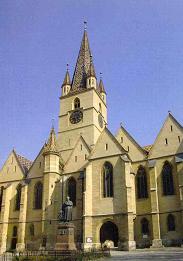 |
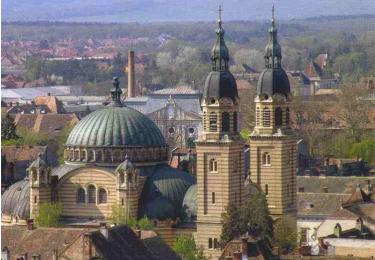 |
| In Sibiu, Haydn was played one year
after the opening night in Vienna, Brahms and Liszt
gave concerts, and the great humanists of the time,
people such as Andrei Saguna, Lucian Blaga, Gheorge
Cosbuc, Octavian Goga, Constantin Noica, and Emil
Cioran lived. Starting with 1704, four orders were
given against smoking, the first vaccines against
smallpox were administered 200 years ago, and the
Brukenthal Secondary School was attested 600 years
ago and the Faculty of Theology more than 200 years
ago. The hospitals and chemist's shops are centuries
old and the technical field may boast its representatives
and their unique work: Conrad Haas and his famous
manuscript on spacecraft (between 1529 and 1559),
Hermann Oberth, who put the scientific bases of space
navigation techniques and designed and built a functional
model of the liquid fuel rocket, the engineers who
built the first Car Plant in Ardeal (more than 100
years ago), the tramway, which is among the earliest
in Europe, the first "firobus" (an electrically powered
trolley) in Romania (built a year later than the one
in New York), the hydropower station at Sadu, electrifications,
railways, etc. |
| Each step means history and present,
and everywhere you will be accompanied by the "eyes
of the city," located on the old roofs. For hundreds
of years they have been the mirror of the soul of
this friendly place, where people of various nationalities
live in harmony, regardless of cultural or religious
background. |
We are looking forward to seeing you
at the conference in July, in the year of the European
Capital of Culture in Sibiu (Hermannstadt).
MSE 2007 Organisation Committee |
For more information
about our university and city, please visit also the following
websites:
www.ulbsibiu.ro
www.sibiu.ro
www.romanianfolkart.ro/muzeulastra
www.brukenthalmuseum.ro
www.ocnasibstrand.ro
|

